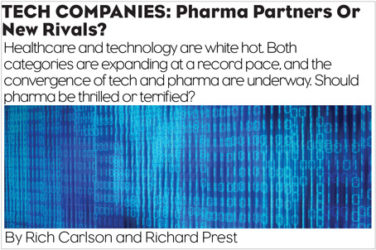Sales teams today are challenged more than ever to reach HCPs. But HCPs have always been hard to reach, haven’t they? Everyone is trying to get a hold of them, gatekeepers protect them, and they are less receptive to sales and marketing tactics. Add to these challenges the onset of COVID-19, and it is easy to understand why getting time is increasingly challenging for the modern sales force.
So, how does today’s pharmaceutical or medical sales team do its job? The answer is by joining forces with their digital marketing counterparts. Yes, counterparts.
While sales enablement has been around for a while, it is time for the medical device and pharmaceutical industries to optimize their digital efforts to complement their sales force. By leveraging today’s top strategies for B2B digital marketing, you can help your sales team establish positive, productive relationships with HCPs.
How to Reach HCPs Effectively with Digital Marketing
With increasing time pressures, “on-demand” digital content is the best way to reach this busy audience, especially since they prefer it. According to a 2020 report published by HealthLink Dimensions, HCP Communications Survey,1 65% of healthcare providers prefer email as their primary communication method for receiving industry news, product updates, and research/educational opportunities.
But your targeted digital communications to HCPs should include a mix of strategies. For example, consider these five tactics.
1. Email marketing: As mentioned, HCPs prefer email (65%) to any other medium, including professional conference exhibits (12%), in-person rep visits (11%), and direct mail (7%).1 Email is also the best way to reach them. GetResponse reports that 21% of opened emails are opened within the first hour, making email one of the fastest ways to send information to busy physicians.2
Email marketing is effective, preferred by HCPs, and it can get granular in how it reaches people. Today, email allows you to target your best prospects, including specialties, hospital or practice, group size, geography, sex, age, and title.
2. Database enhancement: Of course, most pharmaceutical and device manufacturers have built comprehensive HCP databases appropriate for their brands. Beyond primary demographic data and email addresses, databases can include NPI numbers, CPT codes, prescribing data, and diagnoses (ICD 10 codes).
You can expand your email reach and enhance your data through licensing from reputable list and data providers. Depending upon the objective, the list company may deploy emails for you, or you may license the lists to deploy on your own. Be sure that data is “opt-in” verified, authenticated, and maintained. Of course, be sure your email campaigns are fully compliant.
3. Invest in marketing automation: Along with email, marketing automation software helps segment, nurture, and convince HCPs to establish relationships with your sales team. Marketing automation offers:
- Lead scoring that helps prioritize HCPs based on your data and their engagement with your online content.
- Alerts for sales teams when HCPs become active with your content.
- Customized emails sent to HCPs based on their interaction with your emails and online content.
- Nurture campaigns that can continuously present new, helpful content to your HCP audience.
- Integrations with your CRM.
4. Create educational content that HCPs want: While HCPs are busy professionals, they are also classic consumers. They want information tailored to their knowledge level, experience, and lack of time.
In HealthLink’s 2020 study, physicians said they want “trusted, unbiased information.” They want to “know about continuing education programs and product approvals.” They also appreciate patient education materials; 75% of physicians also said they use patient education materials when provided to them.
Invest in creating educational content for HCPs. How does this support your sales team? Physicians who find credible information on your website are more likely to establish relationships with your sales force. Plus, educational content published online is repurposable as in-person handouts and materials. For example, consider content types such as blog posts, eBooks, infographics, webinars, white papers, podcasts, case studies, and videos.
5. Use social media and programmatic digital advertising: According to the same HealthLink 2020 study, the top three social media networks that physicians actively participate in are Doximity (24%), Facebook (22%), and LinkedIn (15%). Additionally, 61% of physicians said they see value in social media and plan to participate in it in the future.
What type of content do they want to see on social media? Most HCPs use social media as a place to create communities with their peers. Consider starting relevant conversations on social media and getting HCPs engaged in the discussions. HCPs also use social media to communicate with patients and educate the public, so it is essential to provide them with content to aid in those efforts.
When it comes to social media, you can promote organic content through your accounts or invest in paid social media advertising. Organic content can be snackable versions of the content you host on your website, such as infographics, charts, or short messages with visuals. Quick information will be liked and shared by HCPs because it is credible, concise, and educational.
Using paid social media and programmatic digital advertising, you can stay in front of HCPs where they naturally go online. Let’s take Facebook, for example. You can target physicians by education, profession, interests, and associations on this social media platform.
Remember that house email list? It comes in handy with paid social media and programmatic digital advertising, too. You can use email addresses in your house list as unique digital identifiers associated with known physician NPIs. Using this tactic, you can reach the personal and business emails of physicians across all devices. With Facebook again as our example, you can now target at NPI level using your third-party data.
How to Create Captivating Content for HCPs
To further ensure you are developing content that will grab the attention of HCPs, follow this five-stage process based on best practices related to B2B messaging.
1. Build an editorial calendar: Before you can develop quality content for HCPs, you’ll need an editorial calendar to keep everyone on track. Editorial calendars help marketers stay consistent. They also assist marketing teams in maintaining quality by better planning for the content they intend to publish. We recommend creating an editorial calendar that aligns with your brand strategies and delivers relevant content that can include evergreen content, newsworthy pieces, and editorial information.
2. Be mindful with messaging: Although physicians are busy and often overwhelmed, they are also human beings. Today’s best content uses messaging filled with empathy and a deep understanding of the target audience. Take the time to develop proper personas for HCPs.
Here is where you can join forces with your sales team. Find out information about the HCPs you want to target, including their pain points and how your product/services help solve their problems.
It is also essential to consider the physician’s journey, just as you would think about any other buyer’s journey. After the initial awareness stage, the goal is to offer a compelling argument that proves your organization or brand will benefit their patients or practice.
With developed personas, you can craft customized content based on where the HCP is along the adoption journey.
3. Content for awareness: If you want HCPs to get to know you, focus on creating content that generates traffic, including articles, blog posts, partnership content, features, and PR collateral. Consider content partnerships with publications, associations, and corporations.
4. Content for consideration: Here is when you demonstrate your value to HCPs. They know who you are, as well as what they want or need, and now they are in the early stages of research. It is time to let them know that you are aware of their pain points. The consideration stage can include thought leadership pieces, industry publications, how-tos, tips, and educational resources.
5. Content for analysis and decision: The last stage is the analysis stage, giving HCPs what they need to decide final decisions about your product. During this stage of the journey, valuable content includes clinical data, case studies, testimonials, and high-profile or industry-leading endorsements.
Finally, so that they can make a well-informed decision, do not forget to offer information that will support their decision, including webinars and sales collateral.
When developing content along any stage of the process, keep these tips in mind:
- Include relevant social share buttons on blog posts
- Add Tweetable quotes in blog posts
- Include key phrases in content and images to increase SEO
- Remain ethical and appropriately communicate your message
- Remember empathy and compassion
- Avoid selling; instead, inform and educate
Email Best Practices
Once you have created your message, you can now ensure that it gets opened and read. When it comes to email, here are some tried-and-true tips:
- Consider rich text emails in addition to formatted HTML
- Optimize frequency and timing: Learn the best time of day and day of the week that your physicians want to receive emails. Often, early in the morning in the beginning of the week works best.
- Keep it short: While longer messages are okay, most physicians want the information quickly and easily.
- Use direct response principles: Your copy should always focus on the immediate moment and encourage the HCP to act. Always remember to include your call to action.
- Be mindful of From and Subject Lines
- Test everything
As a pharma or medical device brand, your sales team needs more support out in the field. With the right investments and tactics, you can leverage digital marketing to establish long-lasting relationships with HCPs.
References:
1. “HCP Communications Survey – Time Sets the Tempo.” HealthLink Dimensions. https://healthlinkdimensions.com/2020-communications-report.
2. https://www.getresponse.com/resources/reports/email-marketing-benchmarks#email-opens-over-time.








